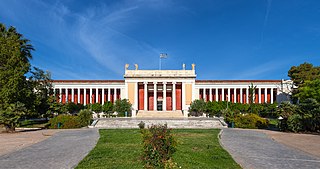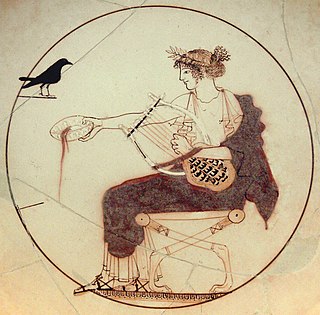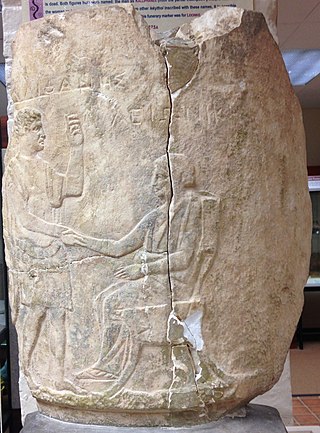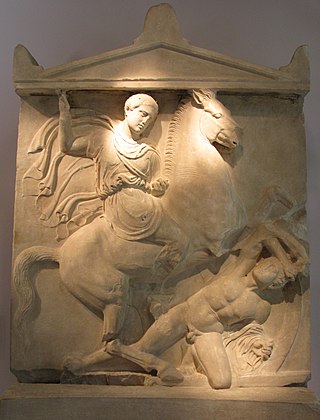
Kerameikos also known by its Latinized form Ceramicus, is an area of Athens, Greece, located to the northwest of the Acropolis, which includes an extensive area both within and outside the ancient city walls, on both sides of the Dipylon Gate and by the banks of the Eridanos River. It was the potters' quarter of the city, from which the English word "ceramic" is derived, and was also the site of an important cemetery and numerous funerary sculptures erected along the Sacred Way, a road from Athens to Eleusis.

Galaxidi or Galaxeidi, is a town and a former municipality in the southern part of Phocis, Greece. Since the 2011 local government reform it is part of the municipality Delphi, of which it is a municipal unit. The municipal unit has an area of 126.088 km2.

The Benaki Museum, established and endowed in 1930 by Antonis Benakis in memory of his father Emmanuel Benakis, is housed in the Benakis family mansion in Athens, Greece. The museum houses Greek works of art from the prehistorical to the modern times, an extensive collection of Asian art, hosts periodic exhibitions and maintains a state-of-the-art restoration and conservation workshop. Although the museum initially housed a collection that included Islamic art, Chinese porcelain and exhibits on toys, its 2000 re-opening led to the creation of satellite museums that focused on specific collections, allowing the main museum to focus on Greek culture over the span of the country's history. This Museum in Athens houses over 100,000 artifacts from Greek history and showcases the many eras, civilizations and cultures which have influenced the development of Greece. Spread over a number of locations, the museum ranks among Greece’s foremost cultural institutions.

A lekythos is a type of ancient Greek vessel used for storing oil, especially olive oil. It has a narrow body and one handle attached to the neck of the vessel, and is thus a narrow type of jug, with no pouring lip; the oinochoe is more like a modern jug. In the "shoulder" and "cylindrical" types which became the most common, especially the latter, the sides of the body are usually vertical by the shoulder, and there is then a sharp change of direction as the neck curves in; the base and lip are normally prominent and flared. However, there are a number of varieties, and the word seems to have been used even more widely in ancient times than by modern archeologists. They are normally in pottery, but there are also carved stone examples.

A loutrophoros is a distinctive type of Greek pottery vessel characterized by an elongated neck with two handles. The loutrophoros was used to carry water for a bride's pre-nuptial ritual bath, and in funeral rituals, and was placed in the tombs of the unmarried. The loutrophoros itself is a motif for Greek tombstones, either as a relief or as a stone vessel. There are many in the funeral area at the Kerameikos in Athens, some of which are now preserved in the National Archaeological Museum of Athens.

The National Archaeological Museum in Athens houses some of the most important artifacts from a variety of archaeological locations around Greece from prehistory to late antiquity. It is considered one of the greatest museums in the world and contains the richest collection of Greek Antiquity artifacts worldwide. It is situated in the Exarcheia area in central Athens between Epirus Street, Bouboulinas Street and Tositsas Street while its entrance is on the Patission Street adjacent to the historical building of the Athens Polytechnic university.

The naiskos is a small temple in classical order with columns or pillars and pediment.

White-ground technique is a style of white ancient Greek pottery and the painting in which figures appear on a white background. It developed in the region of Attica, dated to about 500 BC. It was especially associated with vases made for ritual and funerary use, if only because the painted surface was more fragile than in the other main techniques of black-figure and red-figure vase painting. Nevertheless, a wide range of subjects are depicted.

Delphi Archaeological museum is one of the principal museums of Greece and one of the most visited. It is operated by the Greek Ministry of Culture. Founded in 1903, it has been rearranged several times and houses the discoveries made at the Panhellenic sanctuary of Delphi, which date from the Late Helladic (Mycenean) period to the early Byzantine era.

The National Archaeological Museum of Florence is an archaeological museum in Florence, Italy. It is located at 1 piazza Santissima Annunziata, in the Palazzo della Crocetta.

The Paul and Alexandra Canellopoulos Museum is a museum of antiquities in Athens, Greece. It is situated in the north slope of Acropolis, in the district of Plaka. Founded in 1976, it houses the collection of Paul and Alexandra Canellopoulos, which started being formed in 1923 and was donated to the Greek state in 1972. The collection features ca. 6500 items of Prehistoric, Ancient Greek, Byzantine and post-Byzantine art, spanning almost six millennia of history.

The Archaeological Museum of Delos is a museum on the island of Delos, near Mykonos in the South Aegean, Greece. It is noted for its extensive collection of statues unearthed in the surrounding area of the ancient site, which has been declared a UNESCO World Heritage Site. Although the museum has a considerable collection, it does not contain all of the items found in Delos: a large quantity are on display in Athens at the National Archaeological Museum.

The Archaeological Museum of Eretria is a museum in Eretria, in the Euboea regional unit of Central Greece.

The Reed Painter is an anonymous Greek vase painter of white-ground lekythoi, a type of vessel for containing oil often left as grave offerings. Works are attributed to either the "Reed Painter" or his atelier.

The Museum of Classical Archaeology is the teaching collection of the Department of Classics, Archaeology and Ancient History at the University of Adelaide in South Australia.

Ancient Greek funerary practices are attested widely in literature, the archaeological record, and in ancient Greek art. Finds associated with burials are an important source for ancient Greek culture, though Greek funerals are not as well documented as those of the ancient Romans.

The Grave Stele of Dexileos is the stele of the tomb of an Athenian cavalryman named Dexileos who died in the Corinthian War against Sparta in 394 BC. The stele is attributed to "The Dexileos Sculptor". Its creation can be dated to 394 BC, based on the inscription on its bottom, which provides the dates of birth and death of Dexileos. The stele is made out of an expensive variety of Pentelic marble and is 1.86 metres tall. It includes a high relief sculpture depicting a battle scene with an inscription below it. The stele was discovered in 1863 in the family plot of Dexileos at the Dipylon cemetery in the Kerameikos cemetery of Athens. It was found in situ, but moved during World War II, and is now on display in the Kerameikos Museum in Athens.

The Kerameikos steles are a collection of sculptures used as grave-markers in the Kerameikos necropolis of Attica. Kerameikos is located outside the Themistoclean Wall's Dipylon Gate. Stelai come in various shapes/designs and depict images varying from pottery to narrative scenes. They were often marble or limestone, and were carved or sculpted to depict the person being memorialized sometimes with relatives or slaves. Reliefs decorating the graves were meant to show the dead in their best light, using imagery to recognize their bravery in battle, or pathos, or wealth. These monuments marked the graves of Athenian men, fallen warriors, as well as non-citizens. Women were also included in Kerameikos but typically it was the wealthiest or prominent women who were given stele. In many vase paintings of grave scenes wreaths are seen resting at the base of stele. This was likely a popular way to adorn the graves of Greek loved ones.

The Thanatos Painter was an Athenian Ancient Greek vase painter who painted scenes of death on white-ground cylindrical lekythoi. All of the Thanatos Painter's found lekythoi have scenes of or related to death on them, including the eponymous god of death Thanatos carrying away dead bodies.

The Funerary naiskos of Demetria and Pamphile is a tomb memorial in honour of two deceased women named Demetria and Pamphile, erected in Athens in around 320 BC, shortly after Pamphile's death. It is made of marble and now kept at the Kerameikos Archaeological Museum in Athens, Greece, with inventory number P687, while a copy of it is found on the ancient site of the tomb.


























